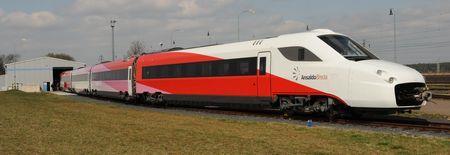
NETHERLANDS: The sorry saga of HSL-Zuid continues, with the news that Transport Minister Camiel Eurlings has put together a rescue package for High Speed Alliance, which he says was teetering on the edge of bankruptcy as a result of the delays in opening the high speed line between Schiphol and the Belgian border.
A joint venture of Netherlands Railways (90%) and KLM (10%), HSA was awarded a 15-year exclusive concession in 2001 to operate domestic high speed services between Amsterdam, Rotterdam and Breda, as well as international services on the Amsterdam – Brussels – Paris route with SNCB and SNCF. According to Eurlings, domestic services were expected to generate around 60% of the revenue.
Infrastructure access charges were set at €148m a year, at 2000 prices. When the concession was awarded, HSA expected to start operating in April 2007. But delivery of the AnsaldoBreda V250 trains has yet to commence, and HSA is still not prepared to set a start date for its interim 160 km/h loco-hauled service between Amsterdam and Rotterdam.
As a result, the concessionaire was faced with paying access charges from July 2009 without any income. Announcing the rescue on January 30, Eurlings explained that the options available to the government were restricted by the need to respect EU rules on state aid and public tendering.
One option would be to cancel the concession and re-tender the services. But EU regulations have changed since the concession was granted, and Eurlings said re-tendering would reduce the yield to the government as the monopoly element could not be retained. Although the state would be able to support operations for a year if HSA went bankrupt, this would not leave enough time to find a replacement operator.
HSA has already received one payment to compensate for the delay in opening the line until October 2008. A second payment, estimated at €19m, will cover the period to the current target opening date in July 2009. In return, HSA will drop its claim against the government that blames delays in drafting the ERTMS specification for the non-availability of rolling stock, a claim that the state denies.
The start of the 15-year concession will be shifted to July, extending HSA’s operating rights until June 2024. Eurlings said this would cost the state €131m in lost access charges, but the money should be recouped later. In any case, he added, HSA was contractually entitled to a 20-week period for trial running before the start of public services.
Eurlings also agreed to provide a temporary exemption from access charges (up to €265m) for three years and perhaps four. HSA must make good this amount before the end of the concession, with interest. Access charges are being reduced by €16·5m a year (at 2008 prices) to compensate for extended journey times between Antwerpen and Brussels and the reduced number of through trains to Paris. During any period that HSA could have operated but was prevented from doing so because the Belgian LGV4 between Antwerpen and the border was not available, HSA’s access charges will be reduced by 40%.
Should HSA still face financial problems because of external causes, the state would consider a permanent reduction in access charges. There is also the possibility of a €50m government-backed bridging loan.
According to Eurlings, new ETCS Level 1 software should be available by the end of April for the leased Traxx locomotives to work the interim service. The substitution of 140 km/h Siemens Class 189s had been considered, but these would need modification to run on HSL-Zuid, even though they are equipped to operate on the Betuwe Route using Level 2. The ETCS-fitted locomotives are also much in demand for freight trains.
Meanwhile, another study is investigating the possibility of using an alternative train control system to get HSL-Zuid into use sooner, if the current problems turn out to be insurmountable. Eurlings said he hopes to issue a further statement in May, but admitted that even if proven technology can be found such a temporary installation could take up to two years to complete.
















